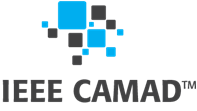CALL FOR PAPERS
The rising number of smart phone subscriptions, which are expected to reach 9.2 billion by 2020, combined with the explosive demand for mobile video, which is expected to grow around 13 times by 2019, will result in a ten-fold increase of mobile data traffic by 2020.To support the unprecedented demand for mobile data traffic, network providers seek novel radio access technologies (RATs) that boost physical-layer link capacity, e.g. massive antenna, utilize additional spectrum, e.g. mmWave radio, or further densify network topology, e.g. small cells.Although such technologies will bring the area spectral efficiency closer to its theoretical limits, most of the functions required to support mobile communications at the end terminals, such as digital signal processing (DSP), interference and mobility management, radio resource management (RRM), are still handled by a single point of attachment at the network edge. This network design and management approach has served the mobile operators well over the past few decades, playing a key role in maintaining network scalability and shifting network management (and processing) from the core to the access network. Besides, it has allowed meeting specific per-user Quality of Service (QoS) or Quality of Experience (QoE) targets.
To this end,the mobile network ecosystem has changed dramatically and now includes: i) a handful of network operators with heterogeneous RATs, ii) small cells that are randomly deployed by the end users, iii) a dense multitude of ubiquitous wireless objects, a.k.a. ‘things’, with diverse functional capabilities, iv) divergent traffic patterns among different networks, markets, and user types, and v) diverse processing, communication and storage capacity at the edge network. Besides, the operational capacity of the network core has dramatically increased due to the pooling of shared communication, computing and storage resources. This drastic transform of the mobile network ecosystem has revealed key vulnerabilities and performance limitations inherent to handling the connectivity of mobile terminals by a single point ofattachment at the network edge, requiring new communication and information processing technologies towards the versatile objectives set by the 5G and Beyond mobile data network.
In light of these challenges, prospective authors are invited to submit original and unpublished work on research topics including, but not limited to, the following:
- Architectures and techniques for massively distributed massive MIMO systems
- PHY and antenna design techniques for 5G and Beyond data networks
- Techniques for massively parallelized Digital Signal Processing in 5G and Beyond
- Cloud-empowered Radio Resource Management algorithms in 5G and Beyond
- Bearer-less plain IP core network architectures, techniques and experimental results
- Predictive and reactive network management platforms for centralized processing in 5G and Beyond
- Popular content placement algorithms and performance evaluation results
- Novel transmission strategies for popular content delivery in 5G and Beyond
- Popular content placement and delivery strategies for improved QoEin 5G and Beyond data networks
- Network coding and waveform design for concurrent downlink transmissions in 5G and Beyond
- Techniques for ultra-reliable data compression in massively distributed MIMO systems
- Terminal-tracking techniques in 5G and Beyond data networks
- Transmission profile selection in 5G and Beyond data networks
- Capacity boosting techniques for the 5G and Beyond fronthaul and backhaul
- Mobility management and flow control strategies in massively distributed MIMO systems
- Massive machine type communications in 5G and Beyond data networks
- Beamforming techniques for the mmWave band
- Novel architectures, techniques and applications for big data–driven network optimizationin 5G and Beyond
ORGANIZERS
Dr. Dionysis Xenakis, University of Athens, Greece
Prof. Ferran Adelantado IFreixer, Open University of Catalonia, Spain
Dr. Elli Kartsakli, Iquadrat, Spain
SUBMISSION
Manuscripts must be prepared in the standard IEEE two-column conference format with a maximum paper length of six (6) printed pages (maximum 1 additional page with over length page charge) and submitted via the provided EDAS link.
CO-SPONSORED PROJECT
The session is organized by the European Marie Curie ITNprojectSPOTLIGHT (http://gain.di.uoa.gr/spotlight).



